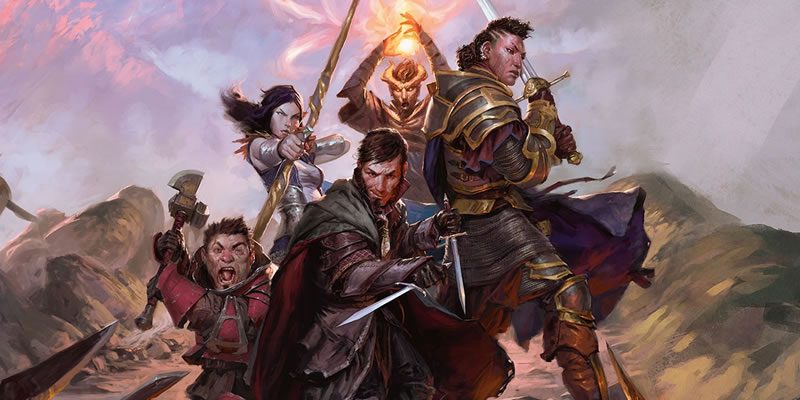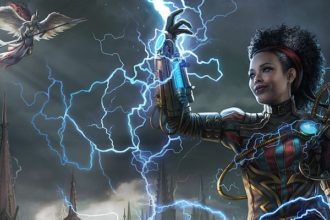A Visit to the Shadowfell – Shadar-kai & More

This week on the Campaign Trail we visit the Shadowfell to look at the Shadar-kai and other inhabitants of this plane. In my next campaign (which is about to start) we’re returning to the Nentir Vale, and I am allowing both Eladrin (elf like inhabitants of the Feywild) and Shadar-kai as playable racial options. The Shadar-kai are extraplanar human-like creatures with tattoos, scars and piercings. The Shadar-kai love to rejoice in battle and have shadowy abilities that are associated with the their home in the Shadowfell. Many, many monsters can be made to easily fit an encounter in the Shadowfell as well. Let’s take a quick trip to the Shadowfell.
About the Shadowfell
When the material world was born, so were its two siblings the dark Shadowfell and the bright Feywild. The Shadowfell is a dimension where nearly everything is black or colorless. This shadow plane is the opposite of the Feywild, a place where darkness consumes the light and the sky is bleak and dim. The Shadowfell is a dark echo of the material world, touching it in places of gloom, death and deep shadow, called Shadow Crossings. When the material world and Shadowfell share familiar landmarks, those on the shadow side appear as twisted and warped copies. The plane is not fully evil, but those who inhabit the Shadowfell generally are drawn to the darkness.

Shadar-kai
In D&D 3rd edition, the Shadar-kai were introduced as a species of fey found on the Plane of Shadow. By 4th edition (see Dragon Magazine #372), the Shadar-kai were set-up as the Fey of the Shadowfell, the opposites of the Eladrin of the Feywild. Ages spent in the Shadowfell have shaped the Shadar-kai into a people that live passionately and fearlessly to combat the apathy and gloom of their home plane. Shadar-kai society is meritocratic and based on power and prestige of great deeds. Most Shadar-kai do not fear death and live for the moment, or risk succumbing to ennui and fading out of existence, experimenting in all sorts of stimulation and extremes.
Cold of heart and dark of eye, passion burns still within these people of shadow and deep winter.
Appearance
The goth-like, Shadar-kai seem to draw in the shadows around them. Their skin ranges from white to dark gray and their eyes are black and lustrious without any white or clear pupil. Their drab or raven black hair is often died and worn in a variety of styles including long and loose, braided, or elaborately shaved. Shadar-kai are usually depicted as having human looking ears. While drab in appearance, these people like dark clothing, jewelry and weapons decorated with a splash of color. They are usually found with tattoos, scarifications, and piercings.
Names
Shadar-kai will occasionally take names from elves or humans, but they usually take names of heroes from their own people or great warriors they respect from outside their people.
Male Names: Ashok, Baden, Chanoch, Emul, Natan, Sithierel, Skagi, Thieraven, Traedis, Vedoran, Zahar
Female Names: Afyn, Bahnka, Codruta, Doru, Ghita, Helayna, Ilvani, Lucya, Markella, Roduka, Zyna.
Shadar-kai Traits
Ability Score Increase. Your Dexterity score increases by 2, and your Intelligence score increases by 1.
Age. A Shadar-kai reaches adulthood at the age of 20 and generally live until they die from their extreme life or fade away centuries after their birth.
Alignment. Most Shadar-kai are chaotic neutral, but lean towards evil.
Size. Shadar-kai are similar to humans, but slightly shorter and thinner. Your size is Medium.
Speed. Your base walking speed is 30 feet.
Darkvision. Accustomed to the dim, colorless Shadowfell, you have superior vision in dark and dim conditions. You can see in dim light within 60 feet of you as if it were bright light, and in darkness as if it were dim light. You can’t discern color in darkness, only shades of gray.
Born in Shadow. You have proficiency in the Stealth skill.
Shadow Jaunt. As a bonus action, you move like a wraith and teleport up to 15 feet to an unoccupied space you can see. You regain the ability to do so when you finish a short or long rest.
Winterkin. Due to your connection to the Raven Queen, you can reroll a failed death saving throw. You regain the ability to do so when you finish a long rest.
Shadar-kai Weapons Training. You have proficiency with the spiked chain and whip.
Languages. You can speak and write Common and one extra language of your choice.
Equipment
| Name | Cost | Damage | Weight | Properties |
|---|---|---|---|---|
| Martial Melee Weapons | ||||
| *Spiked Chain | 15 gp | 1d6 piercing | 5 lb. | Finesse, reach, versatile (2d4), exotic |
* The Shadar-kai train from birth to master the spiked chain. The exotic nature of the spiked chain makes it hard to master for non Shadar-kai and they should require the Great Weapon Master feat, or risk using the weapon with constant disadvantage. Just to be clear this weapon provides 1d6 damage when used one-handed and 2d4 damage when used two-handed.
Other Inhabitants of the Shadowfell
Having just the Shadar-kai isn’t enough. You need more monsters, so try out some of these ideas:
- Shadow creatures such as the Shadow Dragon (MM p. 84-85) can be easily created using a template like the one provided to create this monster from a Red Dragon. Any creature born in (or even pulled into) the Shadowfell can become a shadowy version of its original stat block.
- Change the monster’s damage to necrotic
- Add Sunlight Sensitivity and provide benefits for hiding in the shadows such as damage resistance of some kind
- Shadows sneak up on you, so bump up your monsters ability to hide and attack from the shadows
- Most humanoids can be found in the Shadowfell, but the color should be literally pulled out of them making them pale and dressed in drab clothing.
- Anything undead is a great fit for the Shadowfell, since ghosts of the dead pass through this plane on their way to their final destination. Ghouls, ghasts, ghosts, skeletons, spectres, wights, wraiths and zombies are all a good match.
- Cloakers and darkmantles could be found in your Shadowfell too.
- Other horror themed creatures are a great fit here too such as gargoyles, hags, ravens, vampires and even dhampirs. Tons of ideas can be pulled for Curse of Strahd too.
- ADDED: The players can run into shadow versions of themselves or a shadow NPC could replace, or try to replace their PC/NPC twin (thanks Robert M. for this idea).
Visiting the Shadowfell & Creating Atmosphere
- Domains of Dread can be found in the remote corners of the Shadowfell and offer a different way to experience the gloom and despair of the Shadowfell. Curse of Strahd takes place in one of these Domains of Dread, a demiplane called Barovia which is surrounded on all sides by an inescapable fog.
- The Forgotten Realms has a shadowy version of Neverwinter in the Shadowfell callled Evernight that is full of undead. Your players could visit a shadowy reflection of any town or city in your campaign for a short adventure or an entire campaign in the Shadowfell.
- Gloomwrought is the largest city in the Shadowfell and run by Prince Rolan, the Deathless.
- The DMG (p.52) provides rules for using Shadowfell Despair to help immerse your players in the melancholic atmosphere.
- The Curse of Strahd contains an excellent section called Marks of Horror with tips that can be used to create a dark and horrible atmosphere for your game.
The main cover illustration is from the 5e DMG.
The illustration of Shadar-kai by Chris Stevens and Espen Grundetjern accompanied the race’s description in the 4e MM.



